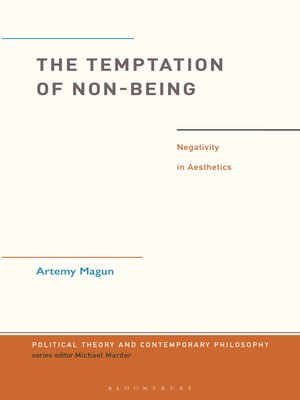The Temptation of Non-Being
ebook ∣ Negativity in Aesthetics · Political Theory and Contemporary Philosophy
By Artemy Magun

Sign up to save your library
With an OverDrive account, you can save your favorite libraries for at-a-glance information about availability. Find out more about OverDrive accounts.
Find this title in Libby, the library reading app by OverDrive.



Search for a digital library with this title
Title found at these libraries:
| Library Name | Distance |
|---|---|
| Loading... |
Why do we enjoy artworks that depict disasters and suffering? Is this a hangover from the Modernist impulse to break the rules of harmony? Is there actually a proper way to perform negativity in art without resorting to nihilism? The Temptation of Non-Being uses these fundamental questions to paint a picture of contemporary art as beset by an outbreak of the negative, and to construct a new theory of art as a medium of complex negativity.
The negative in art is explained not as a simple negation or destruction, but as a multifaceted, polymorphous structure with a vast range of strategies and techniques from parody and pastiche to defamiliarization and non-resemblance. Charting the depth of these negative practices, Artemy Magun shows how they become progressively more complex and explicit, illustrating them with interdisciplinary examples from Lars von Trier, Jacek Malczewski, Andrei Platonov and Fyodor Dostoyevsky. At the heart of this layered, nested structure lies an understanding of Modern aesthetics that helps to answer even more questions: how can the testing, probing nature of art lead to this preoccupation with the negative? Why does this negativity emerge in the first place? What can it tell us about art itself and how it functions in society? This is an erudite and provocative analysis that enriches the ongoing evaluation of both 'high' and 'low' art.
The negative in art is explained not as a simple negation or destruction, but as a multifaceted, polymorphous structure with a vast range of strategies and techniques from parody and pastiche to defamiliarization and non-resemblance. Charting the depth of these negative practices, Artemy Magun shows how they become progressively more complex and explicit, illustrating them with interdisciplinary examples from Lars von Trier, Jacek Malczewski, Andrei Platonov and Fyodor Dostoyevsky. At the heart of this layered, nested structure lies an understanding of Modern aesthetics that helps to answer even more questions: how can the testing, probing nature of art lead to this preoccupation with the negative? Why does this negativity emerge in the first place? What can it tell us about art itself and how it functions in society? This is an erudite and provocative analysis that enriches the ongoing evaluation of both 'high' and 'low' art.







